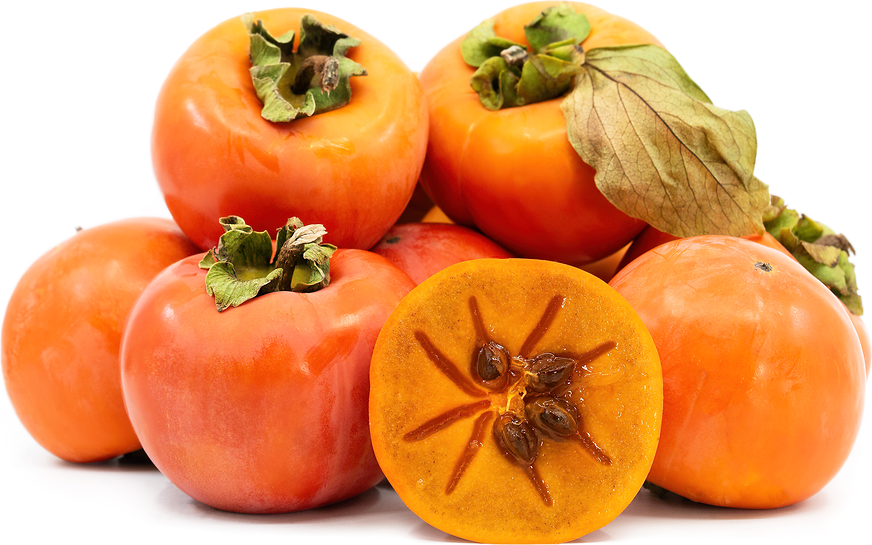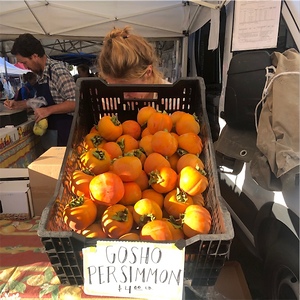


Gosho Persimmons
Estimated Inventory, lb : 0
Description/Taste
Gosho persimmons are a medium to large varietal that bears a round to flattened shape with slightly square shoulders, lightly tapering to a narrower, curved base. The persimmon’s thin skin is smooth and taut with a faint sheen, ripening to variegated shades of dark red, orange, and golden yellow. This variety is known for developing some of the deepest shades of red found in persimmon cultivars. Underneath the surface, the flesh is crisp, aqueous, silky, and smooth with a firm, jelly-like consistency. Gosho persimmons have a tannin-free, sugary-sweet flavor comprised of nuances of warm spices and fruity undertones of apricots, dates, and mangos.
Seasons/Availability
Gosho persimmons are available in the late fall through winter.
Current Facts
Gosho persimmons, botanically classified as Diospyros kaki, are a rare, non-astringent variety belonging to the Ebenaceae family. The large, late-ripening fruits grow on trees that generally reach 7 to 9 meters in height and are a highly prized persimmon in Japan. Gosho persimmons were first cultivated in the Nara prefecture, named after their native city of Goshe, and were discovered sometime during the Muromachi and Edo periods. The fruits grew to be almost twice as large as standard fuyu persimmons, earning them the name Giant Fuyu persimmon and were selected for cultivation for their crisp flesh and sweet flavoring. Despite their favorable eating qualities, Gosho persimmons were difficult to grow, only producing a small fruit crop that easily fell from the tree. These challenging characteristics led the variety to become a luxury fruit, often given to residing shoguns as a gift, also leading the persimmons to acquire the name Hana Gosho, meaning “Flower of the Imperial Palace.” In the modern-day, Gosho persimmons have remained mostly localized to the Nara Prefecture and are also known as Yamato gaki and Hira gaki. The fruits are primarily consumed fresh and are regarded as a delicacy of Nara, celebrated for their rich history.
Nutritional Value
Gosho persimmons are an excellent source of fiber to regulate the digestive tract, vitamin A to maintain healthy organ functioning, and vitamin C to strengthen the immune system while reducing inflammation. The fruits are also a good source of calcium to build strong bones and teeth, vitamin E to protect the cells against free radical damage, and contain other nutrients, including copper, iron, manganese, potassium, vitamin K, and vitamin B6.
Applications
Gosho persimmons have a sugary-sweet, fruity and spice-filled flavor well suited for fresh, cooked, and dried preparations. The fruits are traditionally served raw and are consumed as a palate-cleansing dessert, afternoon snack, or accompaniment to tea. Gosho persimmons can also be chopped and tossed into salads, mixed into fruit bowls, stirred into autumn grains, or served as a fresh topping over desserts and ice cream. Try wrapping slices of the crisp fruit in thin pieces of meat as a savory-sweet appetizer or layer pieces of persimmon over brie toast. In addition to fresh preparations, Gosho persimmons can be used as a pizza topping, quartered and roasted with pork and winter greens, or steamed into a pudding. The fruits can also be incorporated into ice cream, tarts, and pies, frozen and consumed as an icy custard, or poached in spiced syrup as a rich dessert. Beyond fresh and cooked preparations, Gosho persimmons can be sliced and dried for extended use. The fruit’s leaves are also used to wrap sushi in Nara, Japan. Gosho persimmons pair well with fruits such as grapes, apricots, citrus, peaches, pomegranates, and figs, nuts including hazelnut, walnut, and almonds, spices such as cinnamon, cloves, anise, and nutmeg, vanilla, bourbon, honey, and chocolate. Whole, unwashed Gosho persimmons will keep 3 to 5 days at room temperature and for several weeks to a month when stored in the refrigerator.
Ethnic/Cultural Info
Gosho persimmons have inspired several famous phrases and haikus often referenced in Japanese literature. The most renowned reference was in Masaoka Shiki’s autumnal haiku known as the Thought-Provoking Meiji Period Kaki of Taizanro. The haiku states, “Biting into a persimmon, a bell resounds, Horyu-ji.” This haiku was written while Masaoka was staying overnight at the Taizanro ryokan, a Japanese inn located in Nara, in 1895. At his evening meal, the story goes that a beautiful inn attendant gave Masaoka a peeled persimmon. As Masaoka bit into the persimmon, a booming gong of a temple bell rang out, forever imprinting this experience into his memory. The transcendental experience led Masaoka to include the haiku in his essay collection Kudamono, and it is rumored that the Gosho persimmon tree that Masaoka ate fruit from is still alive in the Shiki Garden, well over 150 years old. Another famous anecdote referencing persimmons can be traced to the Muromachi Period. Legend has it that Tokugawa Ieyasu, the first shogun of the Tokugawa Shogunate of Japan, was residing in his Nijo Castle in Kyoto when he heard of residents placing graffiti on city walls. Tokugawa Ieyasu insisted on seeing the graffiti before it was removed, and one of the graffiti writings stated, “Gosho persimmons are ripe alone and fallen under the tree. There is a shogun who picks them up” Tokugawa Ieyasu used this statement and replied with, “Graffiti is not good, but these things can be my reference.” This phrase has become a well-known anecdote used historically throughout Japan.
Geography/History
Gosho persimmons are native to Goshe city in the Nara Prefecture of Japan. Experts believe the varietal was bred sometime during the Muromachi Period, 1338 to 1573 CE, and the Edo Period 1603 to 1868 CE. Gosho persimmons were cultivated on a small scale due to their challenging nature and were mainly given to the residing shogun as a gift. Over time, Gosho persimmons almost disappeared entirely as new fuyu varieties were introduced, but several specialty farms and private orchards preserved Gosho trees to protect the historical cultivar. It is rumored that there are at least fifty old Gosho persimmon trees still producing fruits in Nara today, and the fruits are primarily sold through local markets in the prefecture. Some Gosho persimmons are also exported to specialty distributors in Osaka, Japan.
Recipe Ideas
Recipes that include Gosho Persimmons. One









